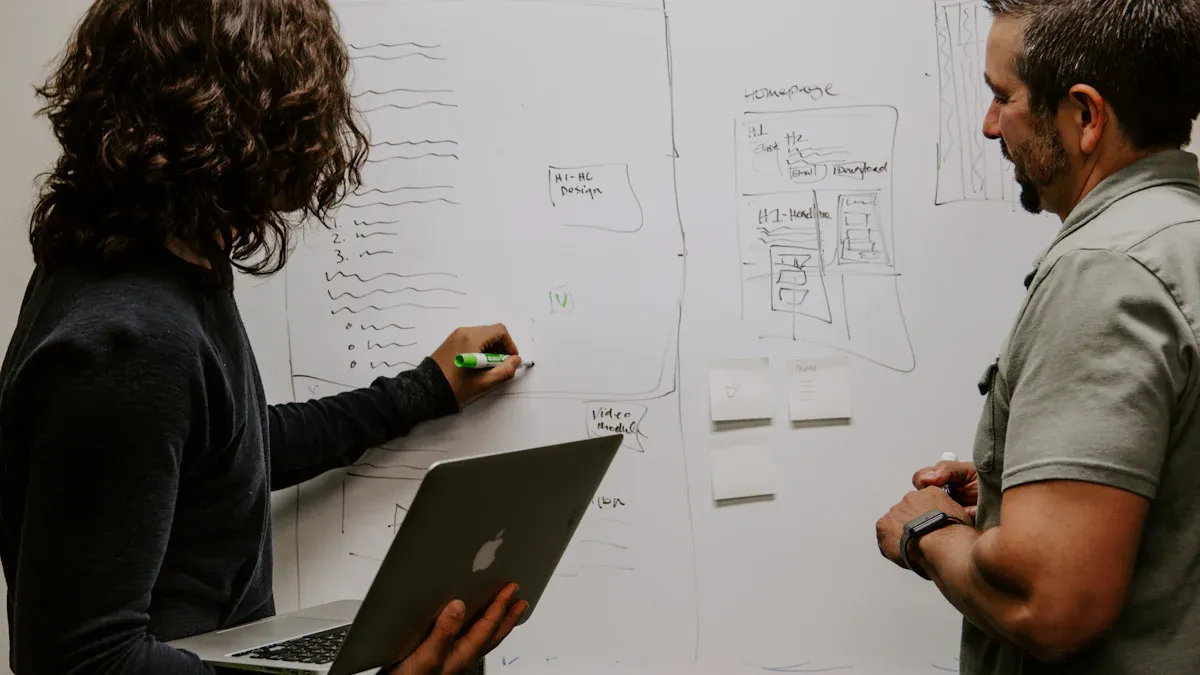Future-Proofing Your Business: Positioning for Success in the New Trade Ecosystem

You see change all the time in business. Future-proofing your business helps you get ready for anything. Big changes around the world require you to adapt quickly. You should focus on future-proofing your brand. Utilize technology and smart strategies to remain resilient. If you need inspiration, look at Fishgoo. They prioritize customers and thrive even when circumstances shift.
Tip: Stay flexible and always keep your customers' needs at the forefront.
Key Takeaways
It is important to future-proof your business. This helps you handle global changes. Stay flexible in your plans. Always think about what your customers need.
Manage risks before they happen. Plan for different situations. This helps you deal with uncertainty. Get ready for problems before they come.
Make money from different sources. This keeps your business safe from market changes. Try new products or enter new markets. This helps you keep earning money.
Use technology and digital tools to work better. This makes customers happier. Start with small changes. Slowly use more automation to help your business run smoothly.
Build strong partnerships with others. Working together makes your business stronger. Share resources and find new markets with partners.
Why Future-Proofing Your Business Matters
Navigating Uncertainty
No one can tell what will happen tomorrow in trade. Some days, things go well for your business. Other days, you might face a new problem. This is why future-proofing matters so much. You want to be ready for anything that could happen.
There are many reasons why things feel unsure. Some risks are not in your hands. Look at the table below. It lists some common risks you might see today:
Type of Risk | Description |
|---|---|
Climate Risks | Potential consequences of climate change, including physical, transition, and liability risks. |
Economic Volatility | Fluctuations in the economy that can impact consumer spending and business operations. |
Geopolitical Instability | Uncertainties arising from political tensions that can disrupt trade and supply chains. |
Technological Disruptions | Rapid advancements that can render existing products or services obsolete. |
Cybersecurity Threats | Risks associated with data breaches and cyber attacks that can compromise business operations. |
You may also see new risks in global trade. These include more protectionism, new trade rules, and extra trade barriers. Sometimes, countries change their laws. This can make it harder to buy or sell goods. Connector countries help keep trade moving, even when things get tense.
Tip: If you know about these risks, you can plan for them. This is the first step to future-proof your business.
Experts think over half expect more trouble and a chance of big problems in the next two years. Almost two-thirds believe the next ten years will be even harder. You should not wait for trouble to come. You need to plan ahead and use smart ideas.
Here are some ways to deal with uncertainty:
Proactive risk management helps you stay alert.
Scenario planning lets you think about different futures.
Supply chain resilience means you do not depend on just one place.
Using technology helps you see risks sooner.
These strategies give you an edge over others. You can act faster and keep your business going, even when things are tough.
Long-Term Success Strategies
You want your business to last a long time. This means you need more than quick fixes. You need plans that help you grow and stay strong for years. Long-term success does not just happen. It takes careful planning and smart moves.
A study in Southeast Asia during COVID-19 showed that companies who changed early did better. Acting early leads to better results over time. If you plan and act before problems get big, your business has a better chance to do well.
Here are some strategies for long-term success:
Strategy | Description | Benefits |
|---|---|---|
Dollar-Cost Averaging | Investing a fixed amount regularly, regardless of price. | Mitigates risk of market timing and fosters disciplined saving habits. |
Diversification | Spreading investments across various asset classes and sectors. | Reduces portfolio risk by offsetting underperformance in one area with stability in another. |
Value Investing | Buying undervalued stocks based on fundamental analysis. | Provides a margin of safety and potential for long-term outperformance. |
Growth Investing | Investing in companies expected to grow faster than the market. | Aims for significant capital appreciation despite higher volatility. |
Dividend Investing | Acquiring shares of companies that pay regular dividends. | Offers a steady income stream and benefits from compounding when reinvested. |
You can use these ideas in your business, not just in investing. For example, diversification means you do not rely on just one thing. You can sell different products or try new markets. If one area slows down, another can help you.
Big companies like Google, Amazon, and Apple check their long-term success by looking at customer feedback, product use, and new ideas. They keep making things better and listen to what people want. You can do this too by tracking what works and changing things when needed.
Note: Planning is not just for big companies. Small businesses can use these ideas to build a strong future too.
When you focus on long-term success, you do more than just get by. You build a business that grows, changes, and stands out. This gives you a real edge and helps you reach your goals, no matter what happens.
The New Trade Ecosystem
Global Trends and Digital Shifts
The trade ecosystem is changing very quickly today. In the last ten years, there have been big changes. Companies now use reshoring and friendshoring to make supply chains stronger. Geopolitical tensions, like those between the U.S. and China, affect trade rules. Many countries want to trade with trusted partners now.
Digital technology is a big part of these changes. Digital tools help international trade move faster. Here are some ways digitalization helps trade:
Digital systems let businesses reach new countries fast.
Online platforms help buyers and sellers find each other.
Digital payment systems make paying easy and quick.
Logistics tracking shows where your order is right now.
Digital processes mean less paperwork and fewer mistakes.
Platforms like Fishgoo show how digital solutions change global trade. Fishgoo lets you buy from Chinese stores, pay online, and track your order. You get a safe, simple, and fast way to shop. This is now normal for trade.
Opportunities in Cross-Border E-Commerce
There are more chances than ever in cross-border e-commerce. The market keeps getting bigger every year. In 2025, it will be worth USD 551.23 billion. By 2034, it could reach USD 2,006.98 billion. That is a big increase, with a 15.44% growth rate each year.
Online platforms help small and medium businesses grow. Fishgoo helps with logistics, warehousing, and payments. You can focus on your products and find new customers around the world. Fishgoo also works with big companies to give you more market access and better service.
But there are some problems when you enter new markets. Each place has its own rules, taxes, and customer laws. You need to learn about the local market to follow the rules. Here are some common problems:
Challenge Type | Description |
|---|---|
Different languages and cultures can make talking to customers hard. | |
Marketing Complexities | Picking the right marketing and audience is different in each place. |
Logistics Issues | Getting orders delivered on time is hard with many carriers and rules. |
Regulatory Hurdles | Following local laws, like VAT and consumer rules, needs special knowledge. |
You can solve these problems by using digital tools, learning about each market, and working with trusted partners like Fishgoo. The digital world gives you more ways to grow and do well in global trade.
Financial Health and Resilience
Cash Flow and Reserves
You want your business to stay strong, even when times get tough. The best way to do this is to keep a close eye on your financial health. Cash flow is the money moving in and out of your business. If you know your cash flow patterns, you can spot problems before they grow. Many business owners perform stress tests on their financial forecasts. This helps you see how a recession or sudden change might impact your business.
Most financial experts say you should keep cash reserves that cover three to six months of operating expenses. This buffer helps you handle the impact of recessions or other surprises. Some people feel comfortable with just one or two months, but having more gives you extra peace of mind. You should also set up backup plans for your financial decisions. When you have strong reserves, you can keep your business running, even if a recession hits hard.
Tip: Always check your financial statements and update your forecasts. This habit helps you spot the impact of recessions early.
Cost Efficiency
Cost efficiency means getting the most value from every dollar you spend. You can boost your financial health by making smart choices. Here are some ways you can improve cost efficiency and reduce the impact of recessions:
Renegotiate vendor contracts often to get better prices.
Consolidate suppliers to make buying easier and cheaper.
Use e-procurement software to track spending and automate orders.
Try remote work to lower office costs.
Review your office lease and look for better deals.
Cut down on inventory waste with better management.
Negotiate payment terms with vendors to help your cash flow.
Encourage everyone in your business to think about saving money.
You can use these steps to protect your business from the impact of recessions. When you focus on financial health, you build a business that can handle any challenge.
Diversifying for Success
Revenue Streams
You want your business to be strong. Markets can change quickly. Building more revenue streams helps you stay safe. If you only have one way to make money, tough times can hurt you. Spreading your income across products or markets gives you a safety net. This keeps cash coming in, even if one part slows down.
Companies with diversified revenue streams are 30% more likely to stay profitable during economic downturns than those with only one income source.
Here’s why having more than one revenue stream helps:
Reduced Financial Risk: If one channel slows, others keep money coming.
Enhanced Market Reach: Different streams bring new customers and open new markets.
Greater Operational Flexibility: You can handle seasons and try new ideas with confidence.
You might sell things online, offer services, or license your brand. Each new revenue stream adds protection. This way, your business has a better chance to succeed for a long time.
Flexible Business Models
Markets change fast. Your business model should change too. Flexible models let you switch when trends or problems come up. Some top companies do this well.
Netflix started with DVD rentals. Then they switched to streaming. Later, they made their own shows. Each change brought new revenue and helped them grow.
Microsoft used to sell software in boxes. Now they offer cloud services and subscriptions. This change brought steady revenue and helped them use new technology.
You can learn from these companies. Try new ways to give value to your customers. Be ready to change. If your business is flexible, you can succeed no matter what happens.
Investing in Technology and Digital Innovation

You want your business to stay ahead of others. Putting money into technology is a smart choice. The world changes fast, and digital transformation helps you keep up. New tools and ideas make your business stronger and more flexible. Companies that focus on innovation can fix problems faster. They also find new ways to grow.
Automation and Data Analytics
More companies use automation and data analytics every year. These tools help you work smarter and save time. They also cut costs and help you make better choices. If you want to future-proof your business, look at what others are doing.
Here’s a quick look at how many businesses invest in these areas:
Source | Percentage of Businesses Investing in Automation |
|---|---|
Duke University | |
Thunderbit | 60% |
Coherent Solutions | 65% |
Source | Percentage of Businesses Investing in Data Analytics |
|---|---|
Coherent Solutions | 65% |
Most companies are already making these changes. You do not want to fall behind. Automation can do simple jobs for you, like tracking shipments or sending updates. Data analytics helps you see trends and fix problems early.
Here are some ways automation and data analytics help you work better:
Smart sensors on containers show where your goods are and if they are safe.
Real-time tracking helps you avoid delays by changing routes when ports are busy.
Data analytics finds the best shipping routes and cuts down on wasted trips.
Advanced analytics show where you lose time or money, so you can fix it.
Sharing data with suppliers helps everyone work together and trust each other.
Fishgoo is a great example of digital innovation. They use automation to manage orders, check product quality, and handle shipping. Their platform gives real-time updates and makes everything smooth. You can see how investing in technology leads to better service and happier customers.
Tip: Start small with automation. Pick one task to automate, then add more as you learn.
Enhancing Digital Presence
You need a strong digital presence to reach new customers. People shop online more than ever before. If they cannot find you online, they might pick someone else. Digital transformation is not just about having a website. It means using every tool to connect with people and show what makes you special.
Here are some top strategies for building your digital presence:
Search Engine Optimization (SEO) helps people find you online. Good SEO tells search engines and customers what you offer.
Social media marketing lets you talk to customers where they spend time. You can share news, answer questions, and build trust.
Other important steps include:
Creating content that people want to read or watch. This keeps them coming back.
Sharing your story and values through positive brand messages.
Using digital marketing to enter new markets and turn visitors into loyal fans.
A good digital marketing plan helps you reach people in different countries. You can change your content for local languages and trends. This makes your business feel close to customers, even if they live far away.
Fishgoo shows how digital transformation can open new doors. They use digital tools to translate product pages, support many payment options, and offer real-time tracking. Their digital innovation makes shopping easy for people everywhere.
Note: You do not need to do everything at once. Pick one area to improve, then build from there.
When you focus on innovation and transformation, you help your business last a long time. Investing in technology today helps you stay ready for whatever comes next.
Sustainability and Compliance
Sustainable Practices
People talk about sustainability a lot now. It is more than just a trend. It is a smart way to run your business. When you care about sustainability, you help the earth and your business. Many people want to buy from companies that care about the planet. The numbers show this is true. Look at the table below:
Evidence Type | Details |
|---|---|
Stakeholder Demand | 85% of investors considered ESG factors in their investments in 2020. |
Brand Reputation | 61% of UK consumers say sustainability is central to their buying decisions. |
Operating Costs | Better waste management can deliver a 10% cost saving. |
Sustainability helps you in many ways. Investors look for it. Customers want it. You can save money by managing waste better. If you use less energy or recycle more, you show people you care. Using eco-friendly packaging also helps. This builds trust and makes your brand special.
Tip: Start with small changes. Try using recycled materials or cutting waste. Every step toward sustainability helps your business grow.
Regulatory Alignment
If you sell in other countries, you must follow many rules. Staying compliant keeps your business safe from trouble. Always learn about new laws and make sure you follow them. Here are some steps you can take:
Check everything carefully before making deals.
Set up a plan to follow rules in every country.
Watch for new sanctions and export rules.
Handle taxes and money rules the right way.
Protect customer data and follow privacy laws.
If you do these things, you can avoid fines and delays. You also show customers you care about following rules. This builds trust and helps your sustainability goals. When you focus on both compliance and sustainability, your business is ready for the future.
Building Resilience Through Partnerships
Strategic Alliances
You do not have to solve every problem alone. Working with partners makes your business stronger. Strategic alliances help you find new customers and markets. You can share resources with others. This helps you stay strong when things get hard. Partners have different skills. You can use their strengths to help your business. This makes it easier to change when you need to.
You can reach new customers and markets.
Sharing resources helps you during tough times.
You and your partners use your strengths together. This helps you handle changes and lower risks.
Fishgoo works with logistics companies, payment providers, and marketing experts. These partnerships help Fishgoo give better service and reach more people. You can find partners who help your business where you need it most.
Tip: Pick partners who have the same values and goals as you. Good alliances help you grow faster and stay strong when things change.
Adaptive Operations
You need to be flexible to keep up with fast changes. Businesses that change quickly can find new trends and chances. Some companies use generative AI to make new products or improve services. Others use cloud computing to work faster and better.
Flexible businesses move fast when new trends show up.
They avoid big losses by being ready for change.
Here are some steps to help your business become more adaptive:
Try new technology to stay ahead.
Use cloud computing and AI to make work easier.
Operational agility means you can change people, processes, and technology quickly. This helps you make fast choices and adjust to new things. When you build adaptive operations, your business can succeed for a long time.
Note: Start with small changes. One new tool or process can make your business more flexible and ready for the future.
Customer Loyalty and Success
Evolving Customer Needs
You know that your customer is always changing. What they want today might not be what they want tomorrow. In global trade, you see new trends all the time. People want more than just a good price. They care about how you treat them and how honest you are. You need to keep up with these changes if you want to keep your customer coming back.
Here’s a table that shows what your customer expects now:
Theme | Description |
|---|---|
Transparency | Customers want honest updates about market changes and shipping costs. |
Realistic Timelines | They expect you to give true delivery dates, not just guesses. |
Options and Trade-offs | Some care about low cost, others want speed or reliability. |
Sustainability Considerations | Many look for eco-friendly choices and want to know about your green efforts. |
If you listen to your customer and adjust your service, you build trust. You also show that you care about their needs. This is the first step in nurturing customer loyalty and boosting retention.
Experience and Trust
You want your customer to feel good every time they buy from you. A great customer experience makes them want to return. Trust is the heart of loyalty. If you keep your promises, your customer will stick with you.
Trust grows when you give clear product details and honest answers.
Fast, reliable shipping makes your customer happy and builds retention.
Easy returns and good support help with retention and show you care.
Ethical actions, like sharing where your products come from, make your customer feel safe.
Tip: When you focus on nurturing customer loyalty, you create a strong bond. Your customer will choose you again and again.
You can see that logistics service quality matters a lot. Good delivery and easy returns lead to higher satisfaction. When your customer feels satisfied, retention and loyalty go up. This is how you build a business that lasts.
You can start getting your business ready for the future now. Try these ideas:
Team up with other companies so you both get stronger.
Look at your money and make sure you can handle changes.
Find new ways to make money so you are not stuck with one.
Use technology to help you work faster and easier.
Keep your customers happy by listening and helping them.
Fishgoo is a good example. They use security, compliance, and flexible platforms to build trust and react fast when things change. If you use digital innovation and smart cross-border plans, your business can do well for a long time. Start now so you are ready for anything that happens next!
FAQ
How can I start future-proofing my business today?
You can begin by reviewing your current processes. Try one small change, like automating a simple task or talking to your customers about their needs. Take action now. Every step helps you get ready for the future.
What makes Fishgoo different from other cross-border platforms?
Fishgoo gives you a one-stop service. You can shop from Chinese sites, pay easily, and track your orders. The platform handles quality checks and shipping. You get support in English and many payment options.
Do I need to be a tech expert to use digital tools for my business?
No, you do not need to be a tech expert. Many digital tools are user-friendly. Start with simple features, like online payments or order tracking. You can learn as you go.
How does digital transformation help me reach more customers?
Digital tools let you show your products to people all over the world. You can use social media, websites, and online ads. These tools help you connect with new buyers and grow your business.
What should I do if I face problems with cross-border shipping?
Tip: Always check your order status and use tracking numbers. If you have issues, contact your platform’s support team right away. Fishgoo offers real-time updates and customer service to help you solve shipping problems quickly.
See Also
FISHGOO’s Future Vision for Global Shipping Innovations
Maximizing Cross-Border E-Commerce Logistics for Global Growth
Exploring Chinese Online Shopping: Tips and Shipping Choices for 2025
Revolutionizing Cross-Border Shopping: FISHGOO’s Global Access to China
Expanding Your E-Commerce Brand Globally with Comprehensive Solutions


